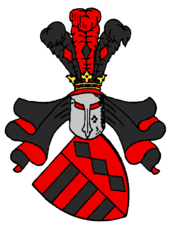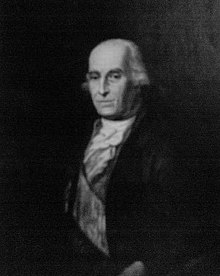Thienen eagle fly
Thienen is the name of an old noble family that the Holstein nobility comes from. The spelling has changed over the centuries from Tyne and Tynen to Tinen, Thien, Tienen, Thinen and Thienen. The Barons von Thienen-Adlerflycht , who belong to the Danish nobility, are the only branch of this sex that has existed to this day.
history
Origin of gender
The genealogist Johann Daniel Eberus describes in his work "Insignia et tabula genealogica dominorum a Thinen", published in 1670, that the von Thienen family is said to have been expelled from Holstein by Charlemagne at the beginning of the 9th century and that the city of Thienen or Tienen ( French: Tirlemont) in Brabant (today's Belgium). The name Thienen first appears on April 20, 872 in a file of Charles the Bald .
At least one branch of the family is said to have had its seat in Dithmarschen since around 1000 , but was expelled from there in 1280. Members of the family fought against the Dithmarschers in 1289, 1322 and 1404, some of them perishing.
The first verifiable member of the family was found in 1314 in a document about the knight Heneke von Thienen, born in 1270 . The certificate is in the Danish State Archives in Copenhagen. The closed line of trunks begins with the knight Johannes von Thienen (dictus de Tyne) , who was born in 1342 and was justiciarus in the Duchy of Schleswig in 1381 . The family was divided early on into several lines on different possessions.
The Barons von Thienen-Adlerflycht belong to the nine still existing Equites Originarii , the primeval , originally knightly families from Schleswig-Holstein .
Today's head of the family is Franz Baron von Thienen-Adlerflycht (* 1957).
Examples of Thienenscher buildings
- Wahlstorf mansion
The original moated castle Wahlstorf was built in the 15th century by Detlev von Thienen and his son Claus and became one of the two family houses. It is one of the oldest preserved mansions in Schleswig-Holstein. After more than 320 years in family ownership, it was inherited in 1788 by the von Plessen family , who still own it.
- Kühren Castle
In 1469 the same Detlev von Thienen also acquired the Kühren estate and built the manor house there, which had now been demolished. The estate remained in the possession of the von Thienen family until 1756 and, along with Wahlstorf, became one of the two family houses.
- Güldenstein Castle
The manor house on Gut Güldenstein was built in 1726 by the Thienen family. The moated castle is located on an oval island and is surrounded by a moat. The Thienen / Brockdorff alliance coat of arms is located above the main portal . In 1779 Güldenstein went to the Rantzau family, and since 1839 it has been owned by the Grand Dukes of Oldenburg.
- Grünholz manor house
The manor on Gut Grünholz was built under Ida Lucia von Thienen, née von Brockdorff, Heinrich von Thienen's widow, from 1749 to 1752 on the remains of the moat that once completely surrounded the farmyard. The building is made of brick in the shape of a cuboid and covered with a hipped roof, the house with two full floors above a basement plinth is nine window axes wide. The central projection facing the courtyard is accentuated by a triangular gable; the building owner's monogram is located in the gable area. The baroque sandstone portal with the double coat of arms of the Thienen and Brockdorff families is reached via a stone bridge. Today the manor is owned by the Princes of Schleswig-Holstein.
- Thienenhof
The former aristocratic palace Prinzesshof or Thienenhof in Itzehoe comes from its oldest components from the 16th century. It is the most important secular building in the city and houses the district museum of the Steinburg district. It was acquired in 1569 by the Steinburg bailiff Otto von Thienen , he built a double house on it and called it Thienenhof from then on.
- Manor house Neu-Bülk
In 1687, Claus Christoph I von Thienen (1657–1708) acquired the Bülk estate in the Danish Wohld . In 1708 he laid out the Meierhöfe Ravensbek (later Neu-Bülk) and Eckhof. His son Claus Christoph II von Thienen (1693–1752) subsequently divided the estate into three parts in order to bequeath it to his children, in this case: The Ravensbek Meierhof expanded into the noble Neu-Bülk estate. The Meierhof Eckhof was extended to the noble Gut Eckhof and the old Bülk manor was greatly reduced and from now on it was called Alt-Bülk.
Barons von Thienen-Adlerflycht
Today only the oldest line of the family (Catholic) still exists, which was awarded the Danish baronate in 1840 as Thienen-Adlerflycht .
The name connection arose due to the marriage of Konrad Christoph von Thienen to Luise von Adlerflycht, the last of an old family from Sweden, in 1833 after the death of her father Justinian von Adlerflycht († 1831) and uncle Carl Friedrich Christian von Adlerflycht († 1835 ).
That same Konrad Christoph emigrated from Schleswig-Holstein. By royal Danish resolution of September 19, 1840 he received the recognition of the name v. Thienen-Adlerflycht and by a royal Danish patent from January 26th 1841 the status increase to Freiherrn or Baron.
His son Karl (born January 23, 1835 in Frankfurt am Main ; † January 28, 1900 in Nice ) was the diplomatic representative of several German princes and duchies in Vienna, in particular as Minister-Resident of the Duchy of Braunschweig for over 30 years , a position from which he retired into private life after the death of Duke Wilhelm (1806–1884).
The Barons von Thienen-Adlerflycht have lived in Austria and the Czech Republic since then .
coat of arms
The family coat of arms is split. It shows three black bars on the right on a red background and three black diamonds on the left on a red background. On the helmet with its red and black covers stand three black, red and black ostrich feathers, each covered with a diamond of a mistaken color. Later the left half is shown divided four times by red and black. The black parts appear mostly in silver between the 17th and 19th centuries. The blooming line, which was raised to the Danish baronate in 1840, again carries the old coat of arms in red and black, with a baron's crown and a falcon and a bear as a shield holder.
Important representatives of the sex
- Johannes von Thienen (1342–1397) Truchsess and Drost
- Beata von Thienen (* 1368), married to Erik von Krummedike, great-great-grandmother of the Swedish king, Gustav I from the Wasa family
- Detlev von Thienen (* 1440), builder of Wahlstorf Castle
- Otto von Thienen, killed near Hemmingstedt in 1500, on Gut Wahlstorf
- Otto von Thienen (1514–1582), bailiff at Tondern on Kühren and Elgaard
- Brigitta von Thienen, prioress of the Preetz monastery from 1570 to 1576
- Kai von Thienen (* around 1675), Brunswick Drost and royal Danish hunter master
- Gosche von Thienen (* 1683), royal Danish land and conference councilor
- Hans von Thienen (1686–1742), Reichshofrat, imperial chamberlain , from 1733 dean of the cathedral chapter in the Lübeck bishopric
- Ludwig Karl von Thienen (* 1718), royal Danish district administrator
- Kai von Thienen (* 1723), Eutinian prince-bishop chamberlain , canon in the Lübeck bishopric
- Wulf Heinrich von Thienen (1721–1809), royal district administrator and secret conference councilor
- Wulf-Heinrich von Thienen (1736–1814), Danish general and court chief (Obersthofmeister) at the Augustenburg court
- Claus Christoph von Thienen (* 1754), royal Danish general and chamberlain
- Konrad Christoph Baron von Thienen-Adlerflycht (1804–1884), Chamberlain, Legation Secretary
- Karl Baron von Thienen-Adlerflycht (* 1835), diplomatic representative of the Danish king and German principalities in Vienna.
- Konrad Christoph Baron von Thienen-Adlerflycht (1924–2010), historian
- Wolfgang Baron von Thienen-Adlerflycht (1951–2007), priest, guardian and provincial vicar in the order of the Capuchins
Castles, manors and estates
Schleswig-Holstein and Denmark
Ahretost , Gut Augustenhof , Bienebek , Borghorst , Bülk , Bundhorst , Cronsburg , Eckhof , Ellgaard , Griesgaard , Goddersdorf , Grünholz , Klein Grünholz , Großenbrode , Großnordsee , Güldenstein , Harzhoff , Klausdorf , Kühren , Löhrstorff , Maasleben , Marienhof , Mehlbek , Mirebüll , Taken , Palais Thienen in Kiel , Petersdorf , Rathmannsdorf , Rethwisch , Schinkel , Sierhagen , Thienenhof or Princesshof , Tollgaard , Tollschlag (Nieharde) , Travenort , Gut Wahlstorf , Warleberg , Warleberger Hof , Gut Wensin , Wippendorf (Kappeler Harde) , Gut Wittmoldt , Wulfshagen (near Tüttendorf ), Wulfshagenerhütten and the Thienenhaus at Pretzer's monastery
Austria
Neuhaus Castle near Salzburg, Katzenberg Castle in Upper Austria
Russia
Jurkino , Litkino , Sinzoro , Kislorka , Kriuscha , Marina
Czech Republic
Today the family owns Lomnice Castle in Brno-venkov and Luhačovice Castle in Zlinsky Kraj
Burial places
literature
- Johann Daniel Eberus, "Insignia et tabula genealogica dominorum a Thinen" published 1670
- Prof. publ. Kilon. Adam Hinrich Lackman and prof. Hafn. Claus Heinrich Moller, “Description of the knightly von Thienen family, who belonged to the duchies of Schleswig-Holstein ...” published around 1750
- Baron Waldemar Weber von Rosenkrantz: Contributions to the history of nobility 2: The family von Thienen. In: Journal of the Society for Schleswig-Holstein History 37 (1907), pp. 221–374
- Genealogical handbook of the nobility , Freiherrliche Häuser A, Volume III (1959) and Volume XI (1979); Freiherrliche Häuser Volume XVIII (1995), CA Starke Verlag
- Genealogical manual of the nobility, Adelslexikon Volume XIV, Volume 131 of the complete series, CA Starke Verlag, Limburg (Lahn) 2003, ISSN 0435-2408
- Danmarks Adels Aarbog, 1935 (general genealogy)
- Gothaischen Genealogischen Freiherrlichen Taschenbücher 1890 to 1940
Individual evidence
- ↑ Karl Freiherr von Thienen-Adlerflycht . In: schlossarchiv.de , accessed on September 22, 2012.
- ↑ Little Chronicle. (...) † Karl Freiherr v. Thienen eagle fly. In: Neue Freie Presse , Abendblatt, No. 12737/1900, February 8, 1900, p. 1, bottom center. (Online at ANNO ).
Web links
- Thienensche estate administration
- Genealogy of the Barons von Thienen-Adlerflycht
- Coat of arms of the Barons von Thienen-Adlerflycht
- Genealogy of the extinct Wahlstorfer line of the family
- Homepage of the Schleswig-Holstein Knighthood
- Historical map of the city of Thienen / Tirlemont ( Memento from December 5, 2012 in the web archive archive.today )










